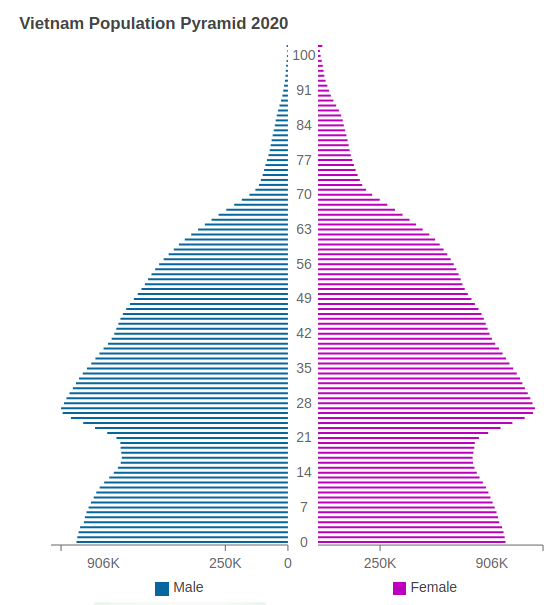Vietnam bets and eases the lockdown
After winning the battle against COVID-19, Hanoi wants to reopen. In fact, it already has
With 324 cases in the country since the start of the epidemic, 263 discharged and no deaths*, Vietnam is a sort of case study on how to deal with the pandemic, which cannot be beaten simply by chance. Strict lockdown measures and the immediate isolation of high-risk areas (it was perhaps the first country to follow Wuhan’s example with the complete closure of a village) seem to be the key to success, most likely in addition to other factors such as the country’s demographic pyramid, the factor which Vietnam is counting on for the resumption of activities.
With nearly 98 million inhabitants, Vietnam shows a rising curve and is expected to reach 100 million inhabitants by the end of 2024, peaking at around 110 in 2054. Vietnam’s population has been increasing by about 1% each year (1 million people) but in reality, the growth rate is decreasing: the fertility rate, which in 1980 was 5 births per woman, has now fallen to 2 as a result of policies to limit the rapid growth. Policies that now need to be reversed, leading the government to introduce incentive measures to reverse declining fertility rates, encouraging young Vietnamese people to marry by 30 to avoid the social problems typically associated with rapidly ageing populations, where there is the risk of having a country with more elderly than young people.
A slowing growth in population is not the only problem in a country that had already committed to development by the end of the last century, when the strict rules of the socialist market were shattered by the Doi Moi reformist policy. Natural disasters linked to climate have killed 15 people and destroyed some 1,700 homes in the first five months of 2020, according to a report published in May by the Committee for Natural Disaster Prevention and Control. Losses due to extreme weather conditions are estimated at around $140 million, with thousands of hectares of damaged rice and horticultural products and over 50,000 damaged homes.
Yet the country is looking forward, including in the fight against climate change: even though the cost of developing renewable energy remains higher than traditional energy, Vietnam already has 92 solar energy and 10 wind energy projects under way, with a total capacity of almost 6,000 MW. It may not be much, but it shows an openness to foreign investment, whose expertise Vietnam recognise be better than national one. The European Union and the French Development Agency (AFD) have recently reached an agreement with the government to strengthen “green” cooperation and increase Vietnam’s resilience to climate change and natural risks. The agreement involves funding of more than $20 million aimed at the development of co-financed investment plans in the 2021-29 period worth an estimated total of about $240 million. The figures may not be huge at the moment, but they indicate a long-term vision by both foreign partners and, above all, Vietnam.
So, there is a focus on young people and families, foreign investment and the green economy, but also on widespread welfare, even where the State and the formal structure don’t reach, that is the large amount of casual work that makes up a key segment of the local economy in Vietnam. The Department of Social Security (VSS) has noted, for example, that the number of people signing up for voluntary social insurance has declined dramatically due to the COVID-19 pandemic, whose effects have obviously been felt here – albeit less than elsewhere. In fact, in the first half of 2020, many companies have reduced their staff and many workers have temporarily stopped working or ended temporary contracts. This has decreased participation in the voluntary social insurance plan, which the government would like to bring to at least 800,000 units per year. The plan is recent and involves a very low proportion of the casual work force, but a growth in policies in 2019 also bodes well for a policy of disseminating information on the benefits of cover, which has suffered a setback due to the virus. Maiinh Mai Hạnh, Deputy Director of the Revenue Division of the VSS, as quoted by the local press, said that up to now around 557,000 workers have voluntary social insurance, a reduction of 16,000 compared to the end of last year and a decrease of 11,000 compared to March this year. However – he added – the aim of increasing this is still possible.
* As of 20 May 2020

